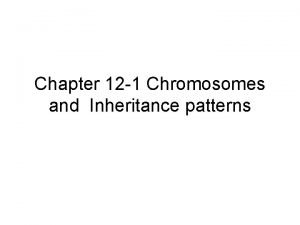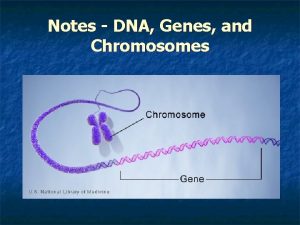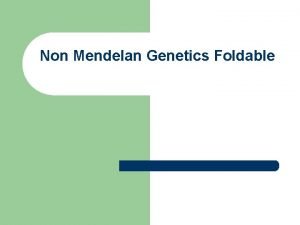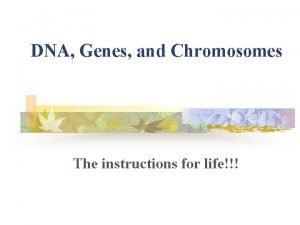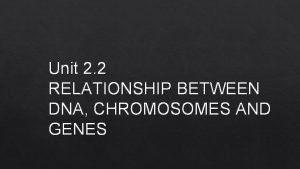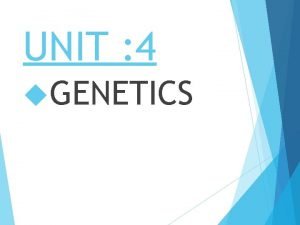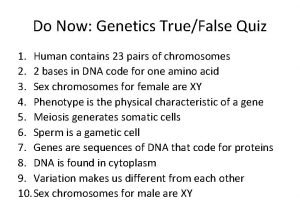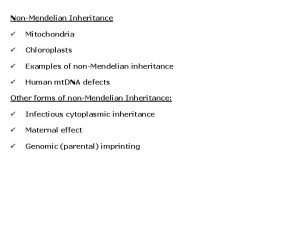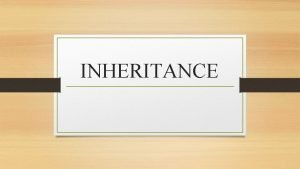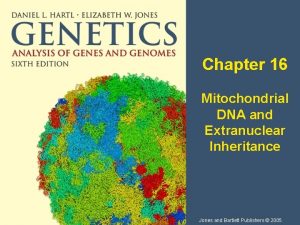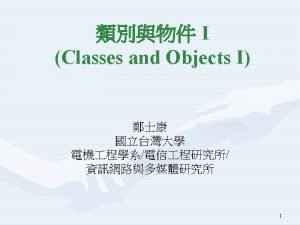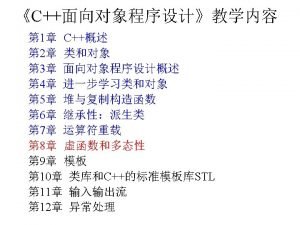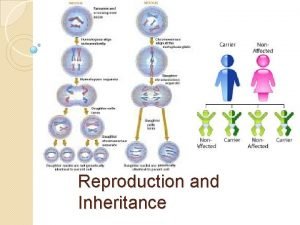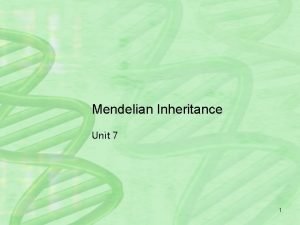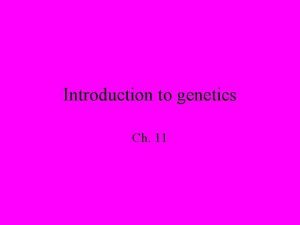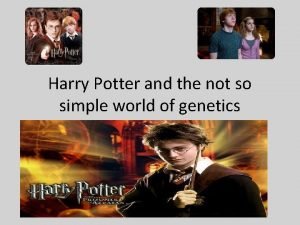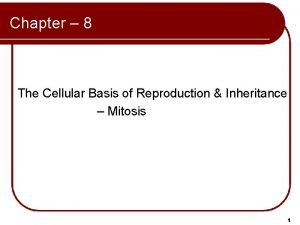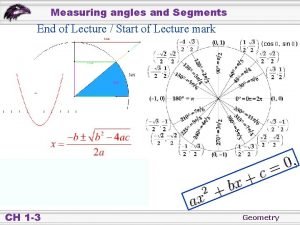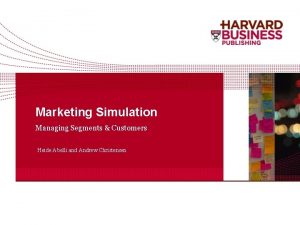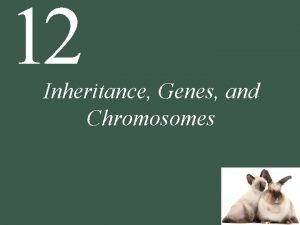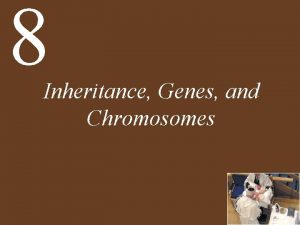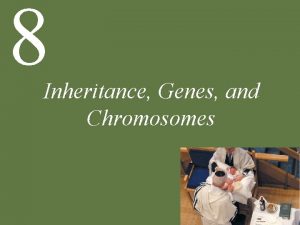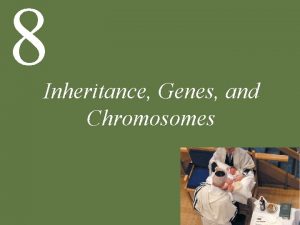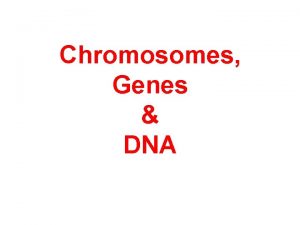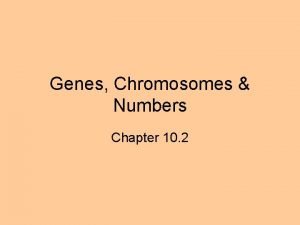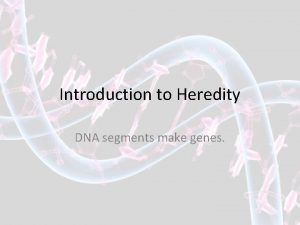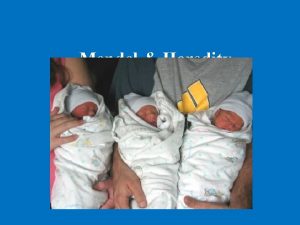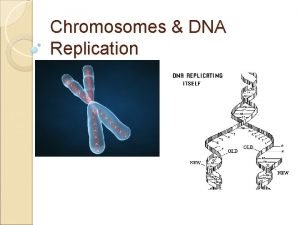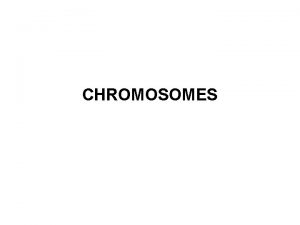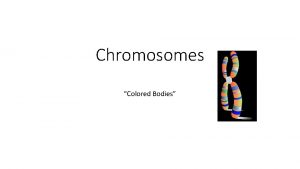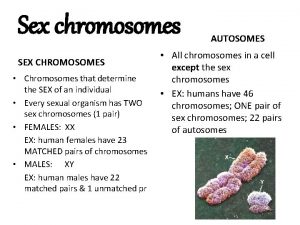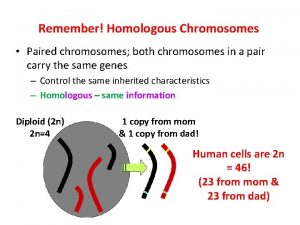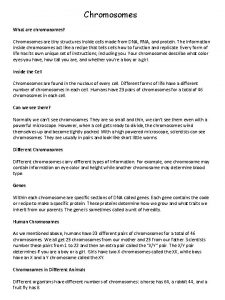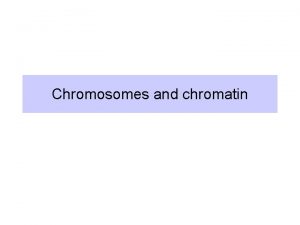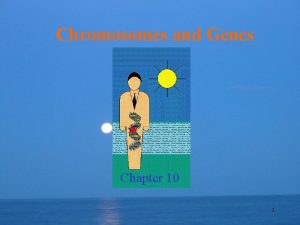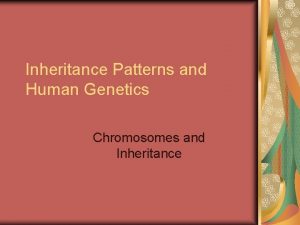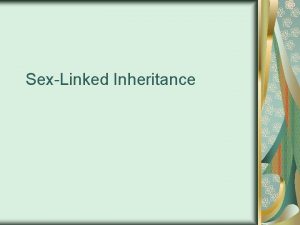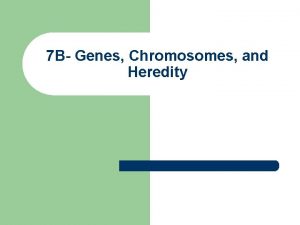CHROMOSOMES AND INHERITANCE Chromosomes and Genes Genes Segments























- Slides: 23

CHROMOSOMES AND INHERITANCE

Chromosomes and Genes ■ Genes - Segments of code that appear on structures called chromosomes • Genes provide instructions needed for living things to be able to grow and function • Each gene contains instructions for coding a particular trait • There are hundreds to thousands of genes on any given chromosome

Chromosomes ■ Chromosomes – Threadlike structures located within a cell’s nucleus containing DNA that is passed from one generation to the next ■ Chromosomes are made at the beginning of the cell cycle (series of events in which a cell grows, prepares for division, and divides to form daughter cells) ■ Every cell in an organism, other than the sex cells, has the same number of chromosomes ■ Chromosomes differ in size, with larger chromosomes containing more genes than smaller ones

Types of Chromosomes ■ There are two types of chromosomes found in every human cell (sex chromosomes and autosomal chromosomes) ■ Humans inherit 23 chromosomes from each parent. ■ Of the 23 pairs of chromosomes, one pair is the sex chromosomes and the other 22 pairs are autosomal chromosomes ■ The combination of genes found on these chromosomes code for the proteins that determine an offspring’s traits

Sex Chromosomes ■ Sex chromosomes – The pair of genes that carry genes that determine whether a person is biologically male or female ■ It is the combination of the sex chromosomes that determines the sex of the offspring • Females have two X chromosomes (X X), one inherited from their mother and one from their father • Males have one X chromosome, inherited from their mother and one Y chromosome from their father (X Y)

Autosomal Chromosomes ■ Autosomal chromosomes – The chromosomes that are not sex chromosomes ■ Humans have 22 pairs of autosomal chromosomes ■ Half of these chromosomes (one from each of the 22 pairs) are inherited from each parent ■ All pairs of autosomal chromosomes are homologous chromosomes

Homologous Chromosomes ■ During fertilization you receive 23 chromosomes from your father and 23 chromosomes from your mother • These chromosomes come in pairs called homologous chromosomes ■ Homologous chromosomes have one chromosome from each parent • The two chromosomes have the same sequence of genes, but may have different alleles • These different combinations of dominant and recessive alleles produce the varying traits offspring inherit

Chromosome Size ■ Chromosomes come in different sizes because the number of genes found on each chromosome, and the length of each of those genes, varies ■ The X chromosomes are almost 3 times the size of the Y chromosomes ■ Due to their larger size • The X chromosomes contain about 16 times as many genes as the Y chromosomes • The X chromosomes code for more proteins and determines more traits than the Y chromosomes

Sex Cells ■ All sexually reproducing organisms form sex cells, which have half the number of chromosomes that body cells have ■ The sex cells (sperm and egg cells) are formed by a process called meiosis ■ Every cell in the human body has 46 chromosomes, with the exception of the sex cells which have 23 chromosomes ■ During fertilization, the sex cells fuse and form a zygote (fertilized egg) ■ The combining of sex cells, during fertilization, results in each body cell containing 2 sets of chromosomes (one set from each parent)

Meiosis ■ Meiosis – A type of cell division that results in the formation of four daughter cells, each having half the number on chromosomes as the parent cell ■ Meiosis starts with the genetic material of the parent cell being copied and condensed into chromosomes ■ Next, during a process called crossing over, a small segment on one homologous chromosome exchanges places with the corresponding segment of the other chromosome (Results in new cells with slightly different combinations of genes) ■ After crossing over, the chromosomes separate and the cell divides into two new cells ■ Each new cell, which now contains half the original number of chromosomes, divides again to create 4 daughter cells ■ Each daughter cell contains a chromatid (created when the chromosomes split in two) which has half of the original parent cell’s DNA

Meiosis vs. Mitosis ■ The two main types of cell division are meiosis and Mitosis ■ Meiosis results in the formation of 4 daughter cells (the sex cells) • The sex cells produced are not genetically identical • Crossing over and the creation of 4 daughter cells results in cells having different genetic information ■ Mitosis is the process in which body cells divide to make 2 new daughter cells • Identical copies of the parent cell’s genetic material (DNA) is distributed into each new daughter cell (body cells) • Mitosis produces 2 identical daughter cells with the same DNA as the parent cell

DNA and Genetic Coding ■ DNA (deoxyribonucleic acid) – The genetic material that carries information about an organism and is passed from parent to offspring • DNA is shaped like a double helix (a twisted ladder) • The structure of DNA consists of sugars, phosphates, and nitrogen bases • The sides of the ladder are made of sugar molecules alternating with phosphate molecules • The rungs are made of 4 nitrogen bases (adenine, thymine, guanine, and cytosine ■ Genes are sections of DNA found on chromosomes • Each gene consists of hundreds or thousands of nitrogen bases arranged in a sequence • Genes direct the construction of proteins, which then affect the traits individuals inherit from their parents

DNA Replication ■ DNA replication – The process by which DNA makes a copy of itself during cell division • As organisms grow and age, new cells form to build and repair structures or to replace cells that have died • Before a cell can replicate, the DNA within the cell must make a copy of itself ■ The process of DNA replication ensures that each chromatid of a chromosome has identical DNA ■ No matter the type of cell division, DNA replication ensures that each cell contains the correct amount of DNA to carry out life processes

Steps for DNA Replication 1. The double helix untwists 2. A protein breaks the DNA in half between the nitrogen bases 3. Nitrogen bases, with a sugar and phosphate molecule attached, pair up with bases on each half of the DNA strand 4. In the end, a chromosome with two identical DNA strands is formed

Trait Variations and Mutations ■ Variation – Any difference between individuals of the same species • May be due to ■ DNA inherited from parents ■ Exposure to certain environmental factors ■ A combination of both inheritance and environmental factors ■ Variations can be helpful, harmful, or neutral

Mutations ■ Mutation – Any change in the DNA of a gene or chromosome • Can be inherited from a parent or acquired during an organism’s life ■ Inherited mutations – Occur when a parent passes on the mutation during reproduction • Present throughout the life of the organism • Found in every cell in the body ■ Acquired mutations – Genetic changes that occur to cells at some point during an organism’s lifetime • Are not hereditary, but occur due to environmental conditions • Can only be passed from parent to offspring if the mutation occurs in sex cells

Types of Mutations ■ Genetic mutations – The result of small changes in an organism’s DNA ■ A small change to a base pair, in a strand of DNA, may cause an incorrect protein to be made during protein synthesis ■ Genetic mutations can occur between one, or several, base pairs ■ Due to the mutation (change in the base pairs), the trait be different from what was expressed before

Sex-linked Mutations ■ Sex-linked Mutations - Occur due to changes on the genes carried on the sex chromosomes (also called the sex-linked genes) ■ Most sex-linked mutations occur on the X chromosome due to it having more genes than the Y chromosome • Many sex-linked mutations are recessive, but are expressed in males due to there not being a gene on the Y chromosome to keep it from being expressed • As result, sex-linked mutations carried on the X chromosome occur less frequent in female offspring than in male ■ Examples: Hemophilia, red-green color blindness, and male pattern baldness

Mutations and the Environment ■ Interactions with the environment and the conditions in which an organism lives has the potential to change the way genes are expressed ■ Environmental factors can change ■ The nucleotides which are the building blocks of nucleic acids ■ The chemical found on DNA ■ Contact with harmful chemicals and radiation (referred to as mutagens) can damage DNA and cause mutations • Some mutagens occur naturally, like radiation from ultraviolet light and x-rays • Synthetic mutagens can be found in pesticides and food additives

Changes in Gene Expression ■ Changes in the way genes are expressed may occur naturally or because of the environment ■ Natural changes in the way that genes are expressed can occur as an organism develops ■ The DNA within the cells does not change, but the genes are read and expressed differently ■ Example: When a caterpillar transitions into a butterfly

Environmental Changes in Gene Expression ■ Environmental factors can affect regulatory processes in the cell that read and express genes ■ Causing genes to be turned on or off or make different amounts of proteins ■ An example can be seen in identical twins that grow up in different environments and acquire different traits as a result ■ Personal choices, such as smoking or unhealthy eating habits, can also be considered environmental factors as they alter the way that genes are expressed

Effects of Mutations ■ Mutations may be harmful, helpful, or neutral ■ Helpful mutations – Help an organism survive in their environment and are often passed on to offspring • Example: Protective coloration (camouflage) which allows an organism to blend with the environment and avoid predators ■ Harmful mutations – Do not benefit the species and often decrease the likelihood of survival • Genetic disorders and cancers are both the result of harmful mutations • While genetic disorders are abnormal conditions that a person inherits, most cancers are caused by acquired mutations that occur from damage to genes during the life of the organism ■ Neutral mutations – Do not affect the organism’s chance of survival • Examples: Hair color or eye color

Using a Pedigree ■ Pedigree – Tool that geneticists use to map out the inheritance of traits ■ Used to trace the genetic origin of nonfavorable traits (like genetic diseases) and predict how they may be passed onto future generations ■ Shows the presence or absence of a trait within a family across several generations (like a family tree) ■ Show which family members express a particular trait as well as those who carry the trait but do not express it
 Linked genes and unlinked genes
Linked genes and unlinked genes Polygenic inheritance
Polygenic inheritance Section 12-1 chromosomes and inheritance
Section 12-1 chromosomes and inheritance Homeotic genes vs hox genes
Homeotic genes vs hox genes The relationship between genes dna and chromosomes
The relationship between genes dna and chromosomes Genetics foldable
Genetics foldable Dna, genes and chromosomes relationship
Dna, genes and chromosomes relationship What is the relationship between dna chromosomes and genes
What is the relationship between dna chromosomes and genes Genes located
Genes located Genes chromosome
Genes chromosome Dna chromosomes genes diagram
Dna chromosomes genes diagram Non nuclear inheritance
Non nuclear inheritance Advantages and disadvantages of inheritance in java
Advantages and disadvantages of inheritance in java Extranuclear inheritance
Extranuclear inheritance Chapter 11 complex inheritance and human heredity test
Chapter 11 complex inheritance and human heredity test Encapsulation inheritance polymorphism
Encapsulation inheritance polymorphism Abstraction encapsulation inheritance polymorphism
Abstraction encapsulation inheritance polymorphism Inheritance
Inheritance Family resemblance test
Family resemblance test Mendel's first and second law of inheritance
Mendel's first and second law of inheritance Sex cat
Sex cat The cellular basis of reproduction and inheritance
The cellular basis of reproduction and inheritance Measuring segments and angles
Measuring segments and angles Heide abelli
Heide abelli


